
UA Local 412 Business Manager Courtenay Eichhorst speaks at the ribbon-cutting event to launch the mobile training unit in November 2023 at Northern New Mexico College in Española, New Mexico.
PHOTOS COURTESY OF UA LOCAL 412
UA LOCAL 412’S MOBILE TRAINING UNIT DELIVERS
PRE-APPRENTICESHIP CLASSES TO DIVERSE
COLLECTION OF STUDENTS ACROSS NEW MEXICO
Business Manager Courtenay Eichhorst and other officials at UA Local 412 in Albuquerque knew they needed to expand their efforts to better serve aspiring tradespeople across New Mexico. Despite operating five training centers statewide, these facilities were insufficient to reach individuals in remote communities.
“We were thinking if we’re going to get some of these good young people from the more remote places, we needed to take the training to them,” Eichhorst said.
That vision is now a reality. Thanks to a partnership between UA Local 412, the North Central New Mexico Economic Development District, and the state Department of Workforce Solutions — and a grant from the U.S. Economic Development Administration (EDA) — a mobile training unit is delivering classroom instruction directly to students.
Eichhorst credits Joan Baker, UA Local 412’s director of outreach and grants manager, for conceptualizing the mobile training unit to reach remote communities. The idea built on their existing use of a trailer equipped with a welding machine and threader for on-site training that they had taken to job sites in remote locations. Expanding this model into a pre-apprenticeship program was a natural next step.
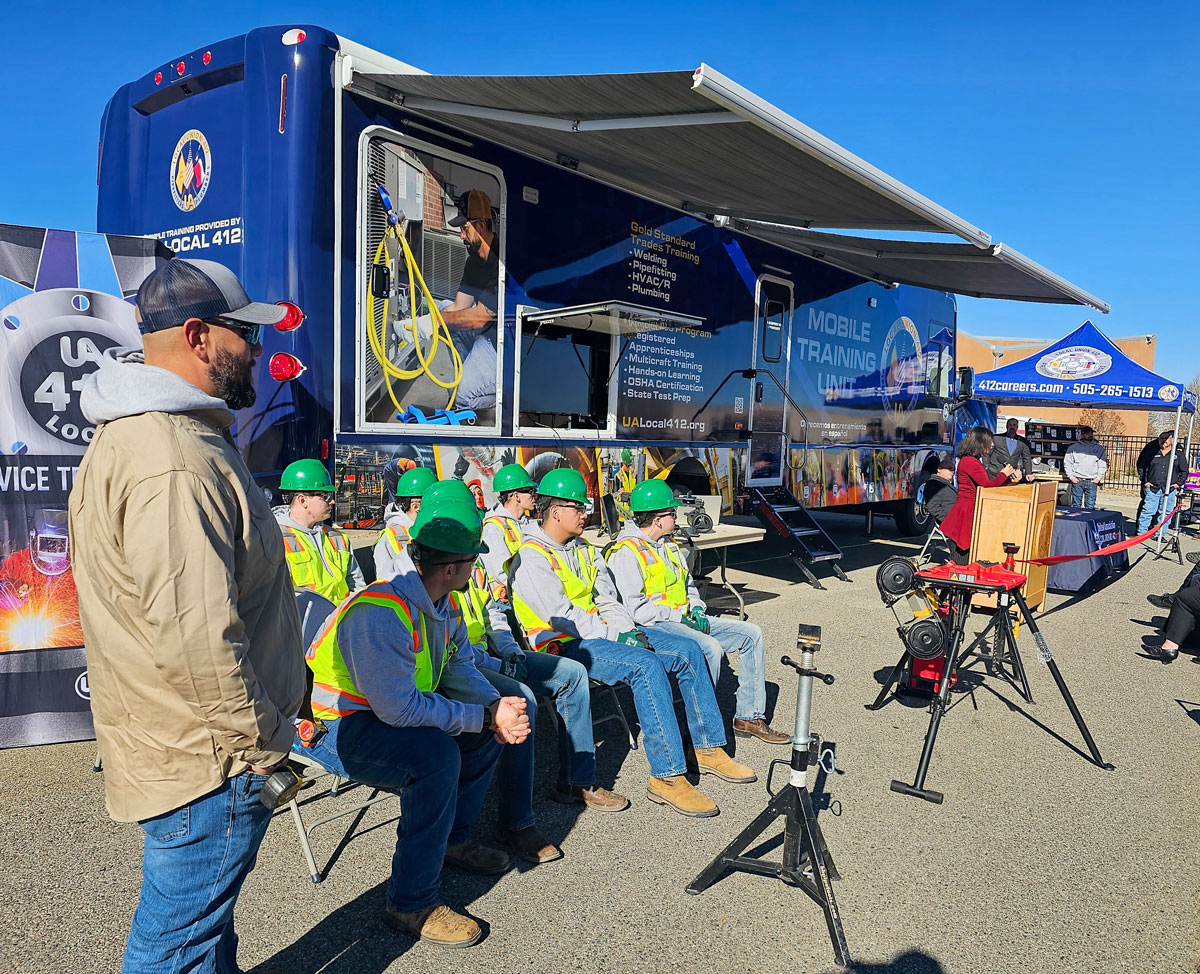
PHOTOS COURTESY OF UA LOCAL 412
Baker spearheaded the program’s development and worked with the North Central New Mexico Economic Development Board — of which Eichhorst is a member — to connect with community, educational and tribal leaders.
This outreach encouraged involvement, especially among New Mexico’s diverse population, including Native Americans, who represent more than 12% of the state’s population.
The program utilizes a 38-foot Winnebago, the largest vehicle available that does not require a commercial driver’s license. It accommodates up to 10 students inside and features a large outdoor TV screen for group instruction with a virtual welding machine.
“Lincoln Electric has a great virtual welder that we use,” Eichhorst said. “The instructor and the whole class get to watch, and they get to learn as a group. And then the next kid gets on and then the next kid and the next person and the next person.”
The 10-week program comprises a three-week, 120-hour skilled trade camp followed by seven weeks of hands-on work with a contractor in the trade of the participant’s choice. It follows the North American Building Trades Unions (NABTU) Multi-Craft Core Curriculum (MC3), a standardized course designed to help young people and transitioning adults choose and succeed in apprenticeship programs that are right for them.
“We have sent quite a few students to the union electricians or the union laborers,” Eichhorst said. “A good, registered apprenticeship — that was our main goal.”
Participants earn $15.90 an hour and are paid by the State of New Mexico Department of Workforce Solutions.
“The contractors get seven weeks with an individual; it’s much more than they get in an interview,” Baker said. “They get seven weeks to determine if this person is right for them, right for their company, and meets the soft skills that they want. So, the contractors are loving the program.”
The initiative is part of the Northern New Mexico Workforce Integration Network (WIN), a project funded by a $6.4 million American Rescue Plan Good Jobs Challenge grant awarded to the North Central New Mexico Economic Development District. The grant covers the bus, instructor, classroom materials, and supplies.
WIN focuses on creating pathways to high- paying jobs in construction and health care, prioritizing underserved populations, including Latino, Indigenous, formerly incarcerated individuals, and those recovering from substance use disorders.
“Some of the students are in their 20s, 30s, 40s, and it’s a life-changer for them,” Eichhorst said. “They had no idea where to go; they had no idea what to do. We had a couple of the kids from Mora — which is in the middle of nowhere — who are actually working at our Intel facility now and they’ve relocated toward Albuquerque.”
Baker estimated that 5% of participants are justice-involved individuals referred through partnerships with organizations like the New Mexico Reentry Center and the Youth Adult Court Program.
“We really focus on vulnerable and special populations, whether they be youth, justice involved, Indigenous, tribal populations, or women; we do a lot to focus on those vulnerable communities,” she said.
For its first two years, the UA Local 412 Plumbers and WIN Mobile Training Unit will serve seven North-Central New Mexico counties: Colfax, Los Alamos, Mora, Rio Arriba, San Miguel, Santa Fe and Taos. It was unveiled Nov. 28, 2023, at Northern New Mexico College in Española, New Mexico, where the first cohort completed certifications in OSHA 10 (workplace safety) and CPR/first aid, and received ladder, confined space, lockout tagout, and sexual harassment trainings.

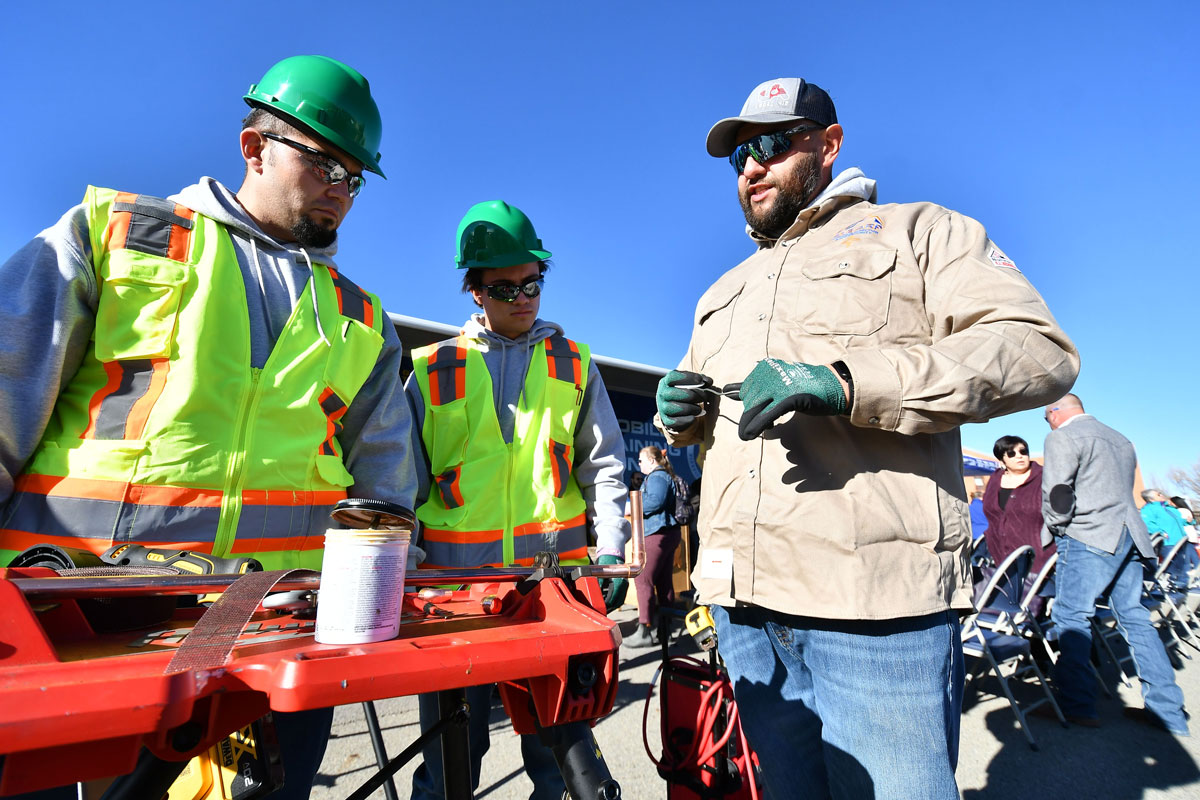
PHOTOS COURTESY OF UA LOCAL 412
UA Local 412 is working with U.S. Sen. Martin Heinrich (D-N.M.) on securing funding beyond September 2026. Heinrich helped obtain $1.3 million for upgraded journeyman training and $1.2 million to expand and acquire new tools and materials for UA Local 412’s Española training facility and has already submitted a request for additional mobile training unit funding.
“Thanks to our Inflation Reduction Act and CHIPS and Science Act, New Mexico is experiencing a manufacturing and clean energy renaissance that is creating new high-quality careers New Mexicans can build their families around,” said Heinrich, who sent representatives to the November 2023 launch. “I’m focused on expanding pathways to skills training and apprenticeships that connect New Mexicans to careers in their own communities. This is how we can address workforce shortages, grow the middle class, and strengthen our economy.”
Eichhorst, who became business manager in 2016, said Heinrich has been a valuable partner to UA Local 412.
“The senator has always been a strong advocate for trade and apprenticeship,” Eichhorst said. “We have worked with him and others to show that the skilled trades offered opportunities to vulnerable populations.”
Frank Lopez, a former UA organizer, moved from Oklahoma to New Mexico to teach the courses. Lopez has taught more than a dozen classes, primarily using the mobile training unit, but also at colleges or the training center in Albuquerque. For the latter, they can accommodate up to 15 students, as did his most recent class. He proudly pointed out they placed all 15 with contractors.
“So far, anybody who wanted to go to work has gone to work,” he said, “and what I mean by that is some kids are like, ‘Hey, yeah, this isn’t for me.’ And I’m like, ‘Cool, great. Thank you for being honest.’”
Lopez integrates real-world job site preparation into his teaching, emphasizing the importance of arriving on time, staying off their phones and even figuring out whether they need to bring a lunch because there may not be nearby stores or restaurants.
“I can teach math, but no program is going to prepare you for what it’s truly like,” he said.
Whenever possible, Lopez arranges site visits with contractors, allowing student to observe professionals in action and experience the work firsthand.
“The guys are working, we’re talking with the foreman, and the kids are seeing what it takes to build a mechanical room, so they get to see it,” Lopez said. “They get the scent, the familiarity of it.”
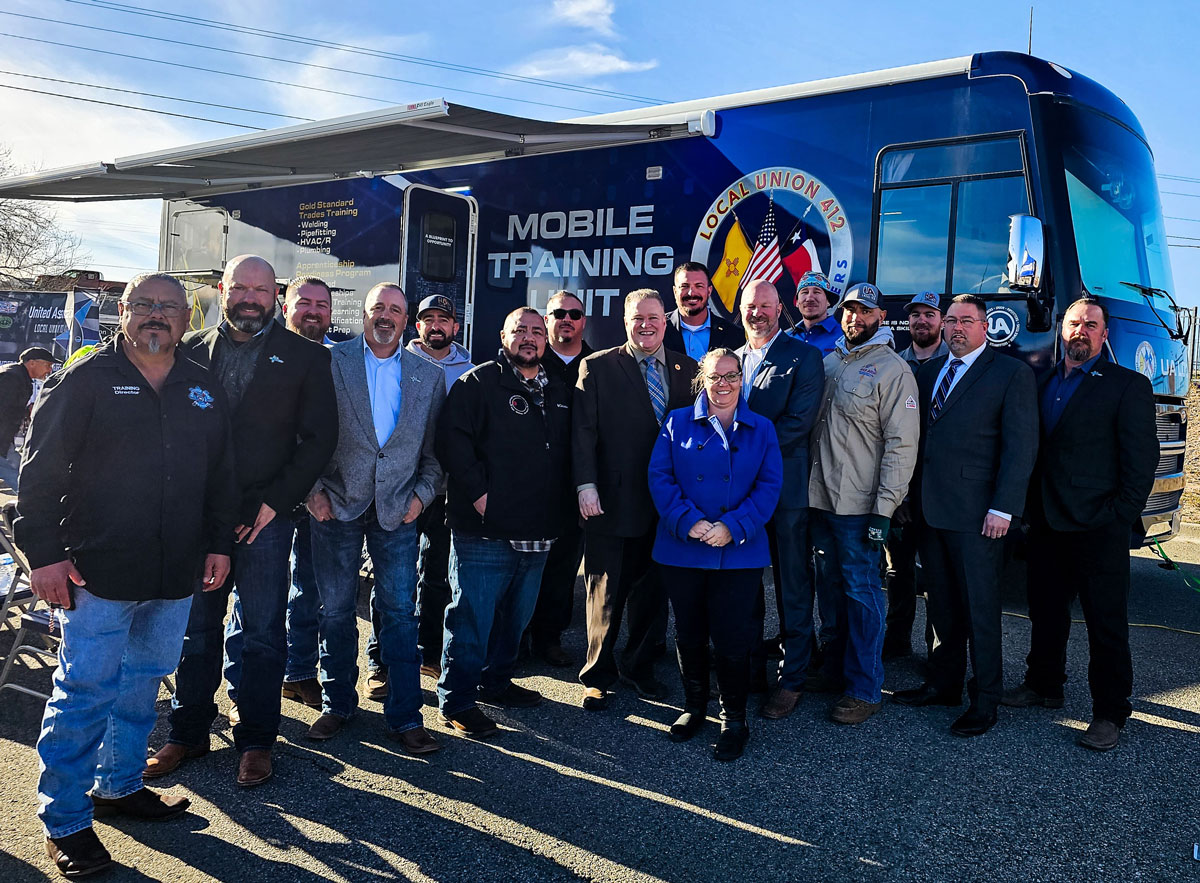
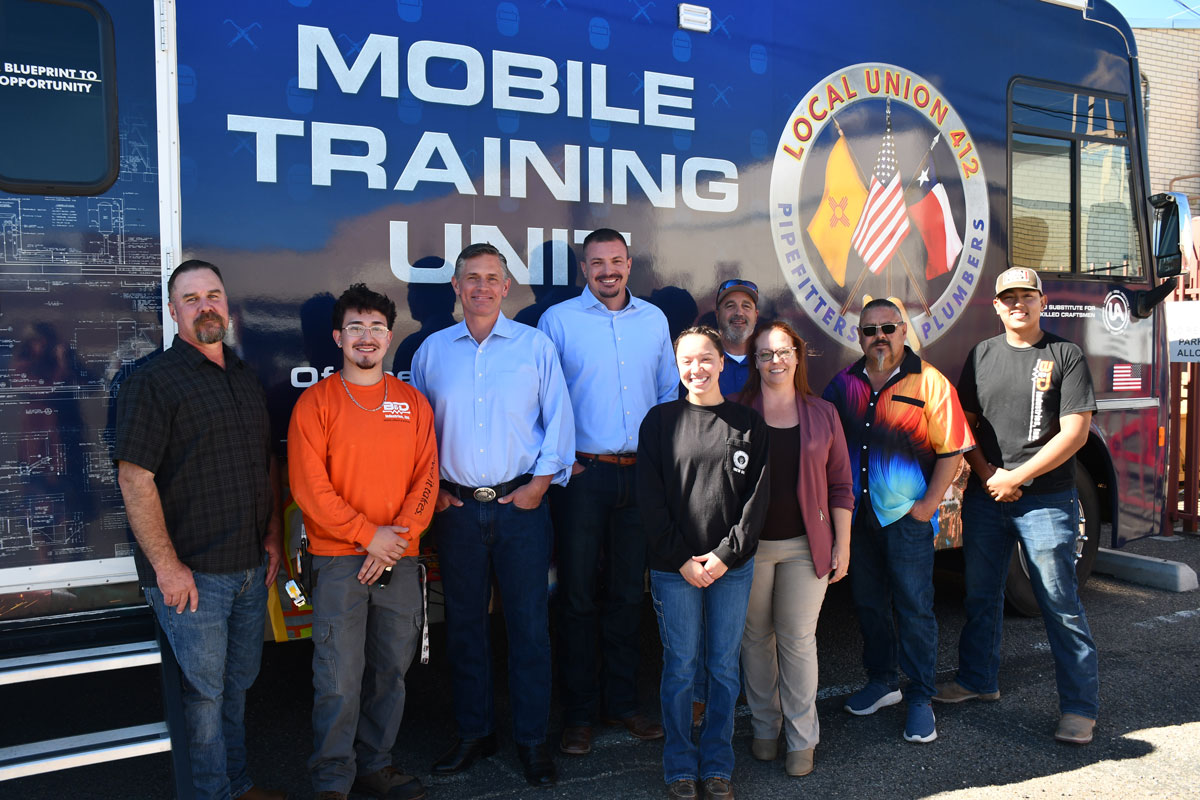
Below: U.S. Sen. Martin Heinrich, third from left, with UA Local 412 staff and program participants at a training demonstration in October 2024. PHOTO COURTESY OF U.S. SEN. MARTIN HEINRICH’S OFFICE
Even when they aren’t visiting job sites, Lopez makes sure to get his students out of the classroom as much as possible for hands-on experience. He provides every one of his students with a hard hat, safety vest, glasses, and gloves, as well as tools including Channellocks, levels, a crescent, and a tape measure.
“We actually go out and build,” he said. “I’ll teach a little bit in the morning, then I take them out to the shop, and then we start building on some stuff, and I show them a project. Not only do we talk about it, we go do it.”
In January, the mobile training unit returned to Española for its first all-female class, continuing a trend of exceeding industry averages for women’s participation.
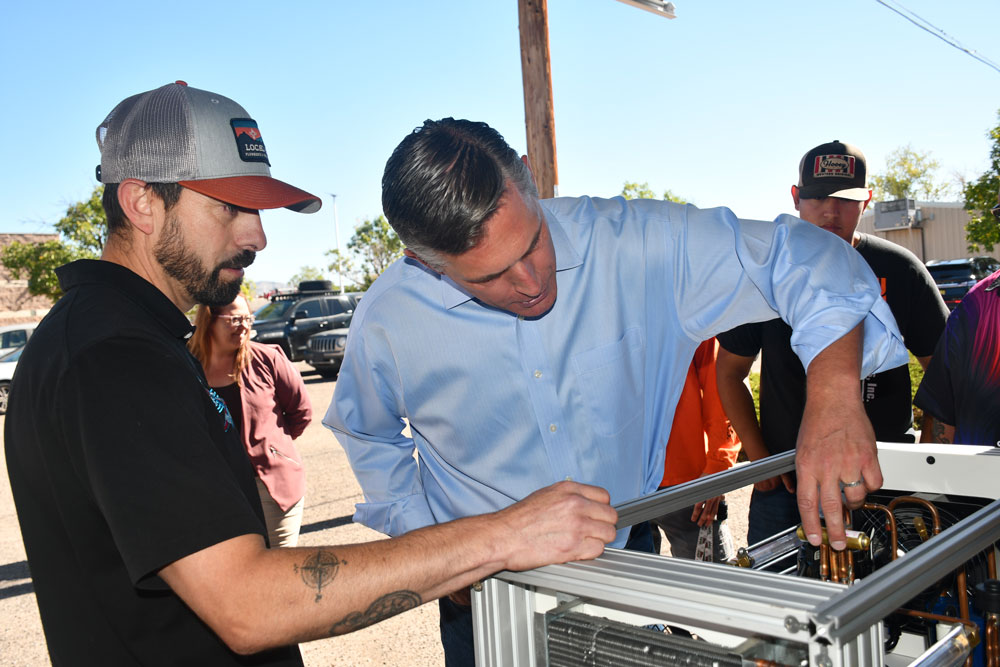
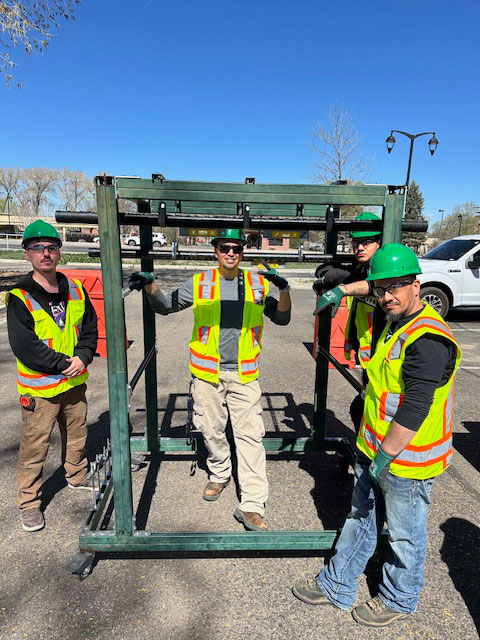
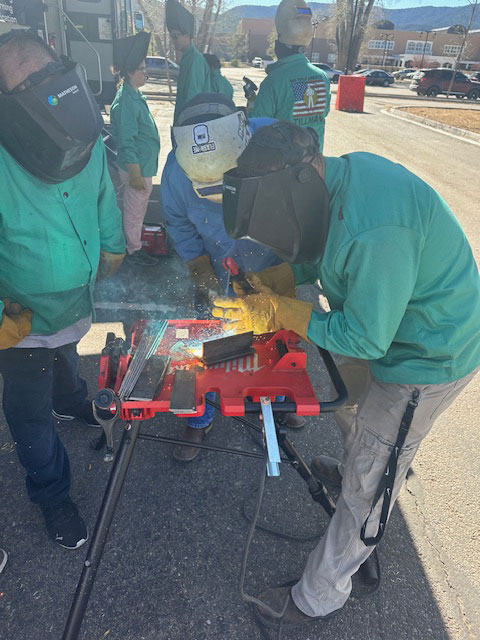
PHOTO COURTESY OF U.S. SEN. MARTIN HEINRICH’S OFFICE
Left: Hanger training in Taos, New Mexico. Right: Welding training in Mora, New Mexico.
PHOTOS COURTESY OF UA LOCAL 412
“Our last cohort that was in Pojoaque was 50 percent women; with only 9 percent women in the industry altogether, that’s huge,” she said. “We had one in Albuquerque that had 25% women. And so, we see that this is a great way for women overall to come into the skilled trades.”
Interest in the program is strong. There is already a waiting list for the next cohort, and contractors are eager to connect with participants.
“It’s definitely in high demand,” she said. “We’re feeding into other building trades apprenticeships because it’s been so successful; we can’t take them all. We’ve been able to fill our apprenticeship rosters, plus some, utilizing this program, and we’ve been able to work with the other building trades unions to place apprentices who are interested in their careers. It’s not only 412; 412 is leading the way for building trades to really open up and develop this program.”
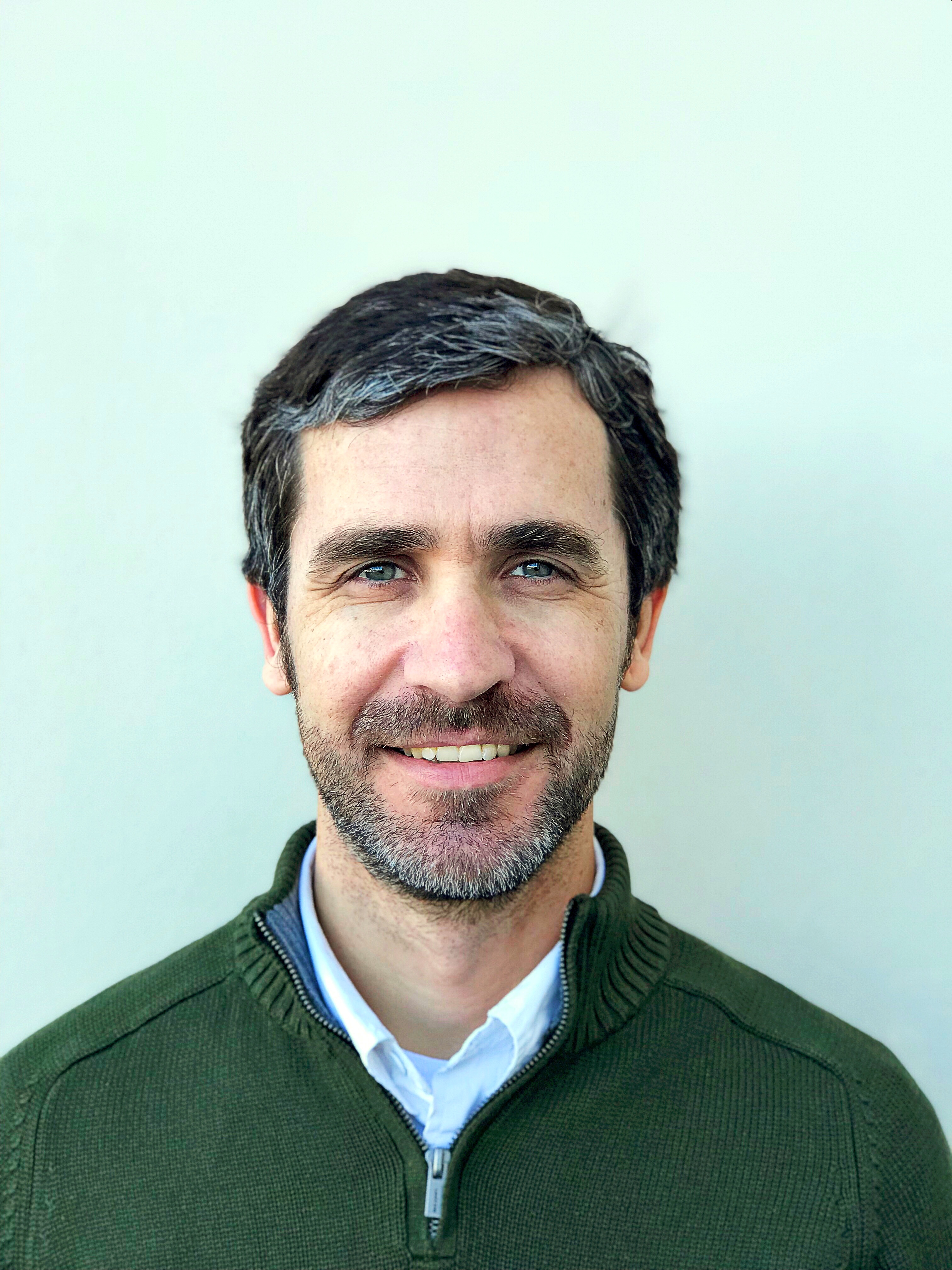
Mike Flenniken is a staff writer, Marketing and Communications, for IAPMO. Prior to joining IAPMO in 2010, Flenniken worked in public relations for a group of Southern California hospitals and as a journalist in writing and editing capacities for various Southern California daily newspapers.
Last modified: February 5, 2025
